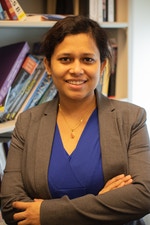Illinois State University received a $403,900 grant from the National Science Foundation (NSF) to purchase a state-of-the-art electron microscope that will aid in research and teaching across campus and the area.
Appears In“This is an amazing resource for ISU and nearby institutions in Central Illinois,” said the grant’s principal investigator, Assistant Professor of Physics Mahua Biswas. “It will move our already cutting-edge research in different levels and open up avenues and hands-on experience for students.”
Known as a field emission scanning electron microscope (FESEM), the instrument can take images of nano-sized objects of different kinds, enabling users to detect intimate details and properties. Putting the minuscule nature of nano-sized objects into perspective: If a particle was the size of the planet Earth, a nanoparticle would be one soccer ball sitting on the planet.
“This grant would change the long-term future of research on campus across departments,” said Biswas, whose lab creates inorganic nanostructures that could be used for emerging nanomaterial-based devices such as in solar cells, LEDs, and high-speed memory chips. Other co-principal investigators of the grant are Assistant Professor of Physics Uttam Manna, Associate Professor of Geology Tenley Banik, Professor of Chemistry Jun-Hyun Kim, and Assistant Professor of Microbiology Jan Dahl.
Research possibilities reach across fields for students and faculty members. “The FESEM allows for questions from folks in physics, chemistry, biology, and more,” said Dahl. “It will expand interdisciplinary work on campus.” More than 20 faculty members from the Department of Physics; the Department of Chemistry; the School of Biological Sciences; the Department of Geography, Geology, and the Environment; the Department of Technology; and University Galleries have shown interest in utilizing the FESEM.
“The new microscope will be an integral part of our experimental nano-photonics research in the Department of Physics,” said Manna. “With the new microscope, we will be able to perform correlated optical and scanning electron microscopy with one-nanometer resolution.”
In years past, faculty members drove nearly an hour to access an electron microscope and run samples collected by students. Once online, the FESEM at Illinois State will provide students faster results and more agency over their work. “After years of having to go off-campus to collect data, I’m looking forward to students taking further ownership of their research projects by teaching them to collect and analyze data on campus,” said Banik, whose students will use the FESEM to continue the study of zircon mineral crystals and the information they provide on crustal growth history.
The new instrument carries specialized features. Energy dispersive x-ray spectroscopy attached to the FESEM will assist in identifying elements of a material and in a nanometer scale area of the material. Cathodoluminescence can detect how much light nanomaterials emit and will be useful to understand the optical properties of the materials. Students will learn how these techniques are used in science for visualization and composition analysis of nanoscale objects,” said Kim.
The electron microscope will also assist with teaching beyond the walls of Illinois State. Biswas is in contact with teachers from Metcalf and University High laboratory schools to expand opportunities for K-12 students. Faculty from Illinois Wesleyan University, Millikin University, the University of Illinois Springfield, and Bradley University have expressed interest in collaborative research and projects.
“The FESEM will do more than push teaching and research to new heights, it will serve as a conduit for collaboration and place Illinois State at the center of advancing science,” said Associate Vice President for Research and Graduate Studies Craig McLauchlan.






